Bollinger Bands are a powerful technical indicator created by John Bollinger. The bands encapsulate the price movement of a stock, providing relative boundaries of highs and lows. The crux of the Bollinger Band indicator is based on a moving average that defines the intermediate-term “trend” based on the time frame you are viewing.
But how do we apply this indicator to trading and what are the strategies that will produce winning results?
In this post we’ll provide you with a solid foundation on the bands, plus six trading strategies you can test to see which works best for your trading style.
But before we do, check out this quick tutorial as a primer for the more advanced concepts discussed below.

Bollinger Bands Overview
Most stock charting applications use a 20-period moving average for the default settings. The upper and lower bands are then a measure of volatility to the upside and downside. They are calculated as two standard deviations from the middle band.
Bollinger Bands Calculation: [1]
Upper Band = Middle band + 2 standard deviations
Middle Band = 20-period moving average (most charting packages use the simple moving average)
Lower Band = Middle band – 2 standard deviations.
The below chart illustrates the upper and lower bands.
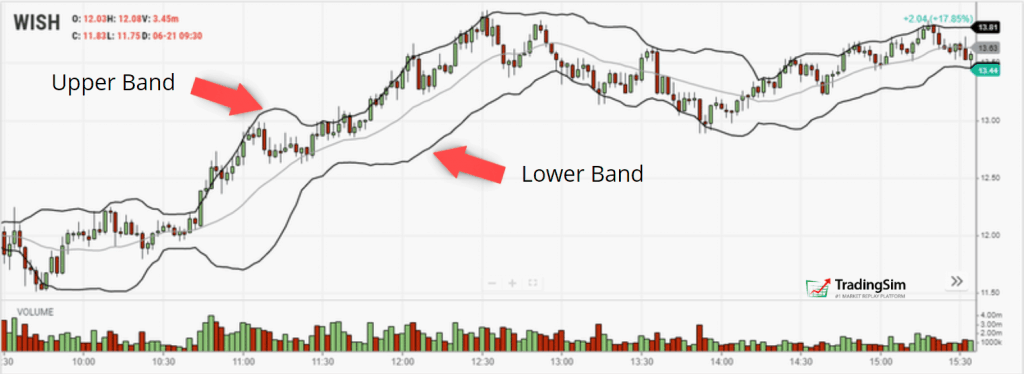
Bollinger BandsIn essence, the Bollinger Band indicator was created to contain price the vast majority of the time. In fact, Investopedia claims that the bands actually contain the price 90% of the time [2].
It is rare for a security to trade outside of the bands. For this reason, it can be used to find an edge in the market.
What is the Ideal Bollinger Bands Settings?
Regardless of the trading platform, you will likely see a settings window like the following when configuring the indicator.
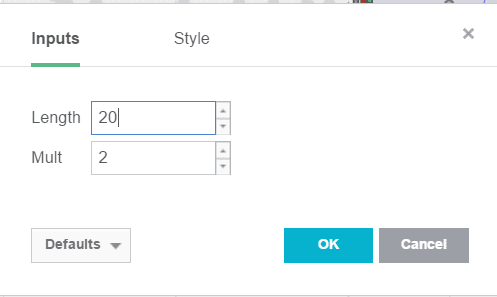
Bands SettingsIf you are new to trading, you are going to lose money at some point. This process of losing money often leads to over-analysis. While technical analysis can identify things unseen on a ticker, it can also aid in our demise as traders.
In the old days, there was little to analyze. Therefore, you could tweak your system to a degree, but not in the way we can continually tweak and refine our trading approach today.
We make this point in regard to the settings of the bands. While the configuration is far simpler than many other indicators, it still provides you with the ability to run extensive optimization tests to try and squeeze out the last bit of juice from the stock.
The problem with this approach is that after you change the length to 19.9 (yes people will go to decimals), 35 and back down to 20; it still comes down to your ability to manage your money and book a profit.
Our strong advice to you is not to tweak the settings at all. It’s better to stick with 20, as this is the value most traders are using to make their decisions, versus trying to look for a secret setting.
Now that we have covered the basics, let’s shift our focus over to the top 6 Bollinger Bands trading strategies.
Bollinger Band Trading Strategies
Many of you have heard of the classic technical analysis patterns such as double tops, double bottoms, ascending triangles, symmetrical triangles, head and shoulders top or bottom, etc.
Bollinger Bands can add that extra bit of firepower to your analysis by assessing the potential strength of these formations.
Let’s unpack each strategy, so you can identify which one will work best with your trading style.
#1 Strategy – Double Bottoms
A common Bollinger Band strategy involves a double bottom setup.
John himself stated [3], “Bollinger Bands can be used in pattern recognition to define/clarify pure price patterns such as “M” tops and “W” bottoms, momentum shifts, etc.”
The first bottom of this formation tends to have substantial volume and a sharp price pullback that closes outside of the lower Bollinger Band. These types of moves typically lead to what is called an “automatic rally.” The high of the automatic rally tends to serve as the first level of resistance in the base building process that occurs before the stock moves higher.
After the rally commences, the price attempts to retest the most recent lows that have been set to challenge the vigor of the buying pressure that came in at that bottom.
Many Bollinger Band technicians look for this retest bar to print inside the lower band. This indicates that the downward pressure in the stock has subsided and there is a shift from sellers to buyers. Also, pay close attention to the volume; you need to see it drop off dramatically.
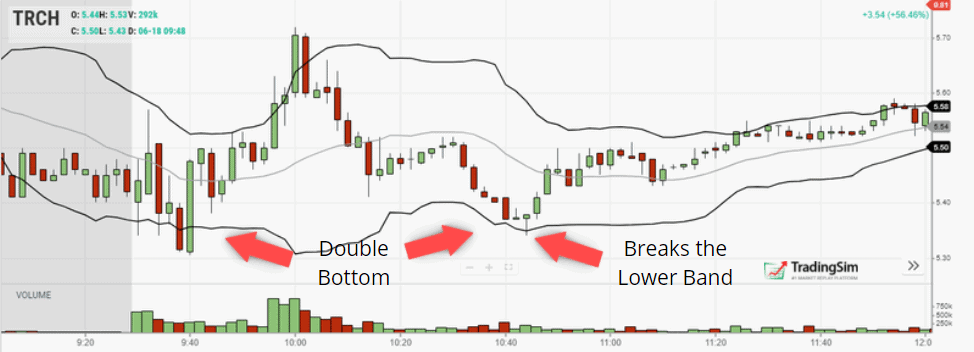
Bollinger Bands Double BottomAbove is an example of the double bottom outside of the lower band which generates an automatic rally. On the secondary test, TRCH tested a new low with a 40% drop in traffic from the last swing low. Also, the candlestick struggled to close outside of the bands. This led to a sharp 100% rally over the next day.
#2 Strategy – Reversals
Another simple, yet effective trading method is to fade stocks when they begin printing outside of the bands. We’ll take this one step further and apply a little candlestick analysis to this strategy.
For example, instead of shorting a stock as it moves up through its upper band limit, wait to see how that stock performs. If the stock goes parabolic or gaps up and then closes near its low while near the outside of the bands, this is often a good indicator that the stock will correct on the near-term.
You can then take a short position with three target exit areas depending on where the stock finds support: (1) upper band, (2) middle band or (3) lower band.
Using the same chart from above, we can see that the rally off the first low created a near term overbought scenario.

Bollinger ReversalAs you can see from the chart, the first red candle after the highs was a bearish engulfing candle. The stock quickly rolled over and took an almost 5% dive in under 30 minutes.
#3 Strategy – Riding the Bands
The single biggest mistake that many Bollinger Band novices make is that they sell the stock when the price touches the upper band or buy when it reaches the lower band.
Bollinger himself stated a touch of the upper band or lower band does not constitute a buy or sell signal. In his book, John states, “During an advance, walking the band is characterized by a series of tags of the upper band, usually accompanied by a number of days on which price closes outside of the band.” [4]
Look at the example below and notice the tightening of the bands right before the breakout.
To the earlier point, price penetration of the bands alone cannot be a reason to short or sell a stock.
Notice how the volume exploded on the breakout and the price began to trend outside of the bands; these can be hugely profitable setups if you give them room to fly.
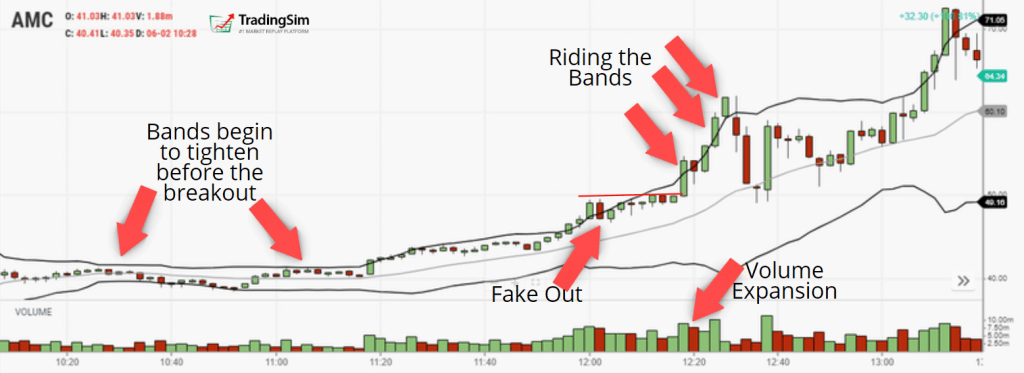
Riding the bandsNotice above in the AMC chart (#3 Strategy) how the Bollinger price expanded on the early breakout.
It immediately reversed with an engulfing candle pattern, and all the breakout traders were head-faked. Along these lines, you don’t have to squeeze every penny out of a trade. Wait for some confirmation of the breakout and then go with it. If you are right, it will go much further in your direction. Notice how the price and volume broke when approaching the head fake highs (red line).
The Middle Band
Just as a reminder, the middle band is set as a 20-period simple moving average in many charting applications.
The middle line can represent areas of support on pullbacks when the stock is riding the bands. You could even increase your position in the stock when the price pulls back to the middle line.
Regarding identifying when the trend is losing steam, failure of the stock to continue to accelerate outside of the bands indicates a weakening in the strength of the stock. This would be a good time to think about scaling out of a position or getting out entirely.
#4 Strategy – Bollinger Band Squeeze
Another trading strategy is to gauge the initiation of an upcoming squeeze.
John created an indicator known as the band width. This Bollinger Band width formula is simply (Upper Bollinger Band Value – Lower Bollinger Band Value) / Middle Bollinger Band Value (Simple moving average).
The idea, using daily charts, is that when the indicator reaches its lowest level in 6 months, you can expect the volatility to increase. This goes back to the tightening of the bands that I mentioned above. This squeezing action of the Bollinger Band indicator often foreshadows a big move.
You can use additional signs such as volume expanding, or the accumulation distribution indicator turning up.
These other indications add more evidence of a potential Bollinger Band squeeze.
We need to have an edge when trading a Bollinger Band squeeze because these setups can head-fake even the best of us.
Example 1
To the point of waiting for confirmation, let’s look at how to use the power of a Bollinger Band squeeze to our advantage. Below is a 5-minute chart of NIO. Notice how leading up to the morning gap down the bands were extremely tight.
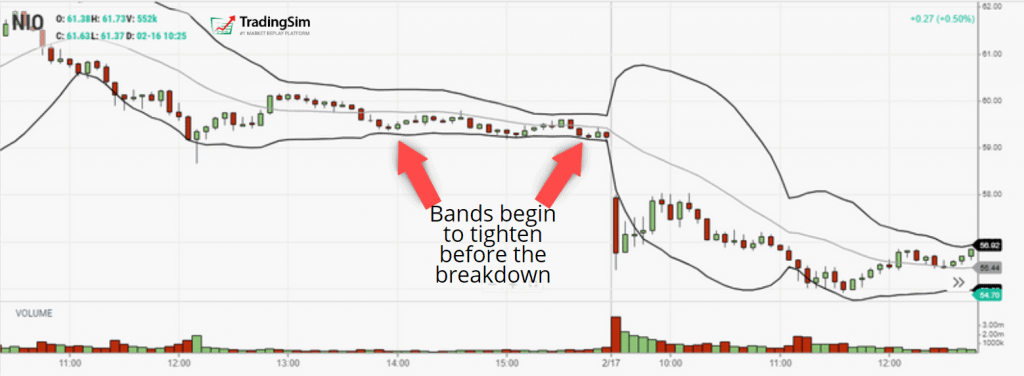
Tightening of the bandsNow some traders can take the elementary trading approach of shorting the stock on the open with the assumption that the amount of energy developed during the tightness of the bands will carry the stock much lower. Another approach is to wait for confirmation of this belief.
So, the way to handle this sort of setup is to (1) wait for the candlestick to come back inside of the bands; (2) make sure there are a few inside bars that do not break the low of the first bar; and (3) short on the break of the low of the first candlestick.
Example 2
Based on reading these three requirements you can imagine this does not happen very often in the market, but when it does, it’s powerful. The below chart depicts this approach.
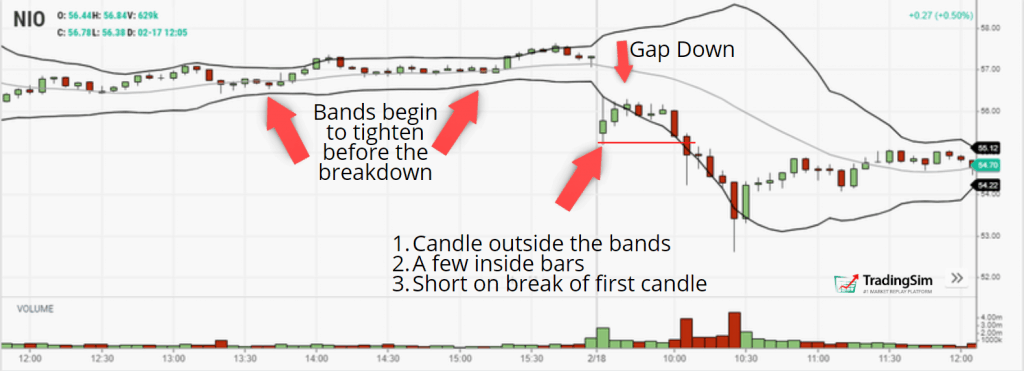
Gap down squeezeExample 3
Now let’s look at the same sort of setup but on the long side.
Below is a snapshot of NIO from October 29, 2020. Notice how NIO gapped up over the upper band on the open, had a small retracement back inside of the bands, then later exceeded the high of the first candlestick. These sorts of setups can prove powerful if they end up riding the bands.
#5 Strategy – Snap Back to the Middle of the Bands
This strategy is for those of us who like to ask for very little from the markets. Essentially you are waiting for the market to bounce off the bands back to the middle line, which carries a high winning percentage over time.
In this setup, you are not obsessed with getting in a position for it to swing wildly in your favor. Nor are you looking to be a prophet of sorts and try to predict how far a stock should or should not run.
By not asking for much, you will be able to safely pull money out of the market on a consistent basis and ultimately reduce the wild fluctuations of your account balance, which is common for traders that take big risks.
The key to this strategy is waiting on a test of the mid-line before entering the position. You can increase your likelihood of placing a winning trade if you go in the direction of the primary trend and there is a sizable amount of volatility.
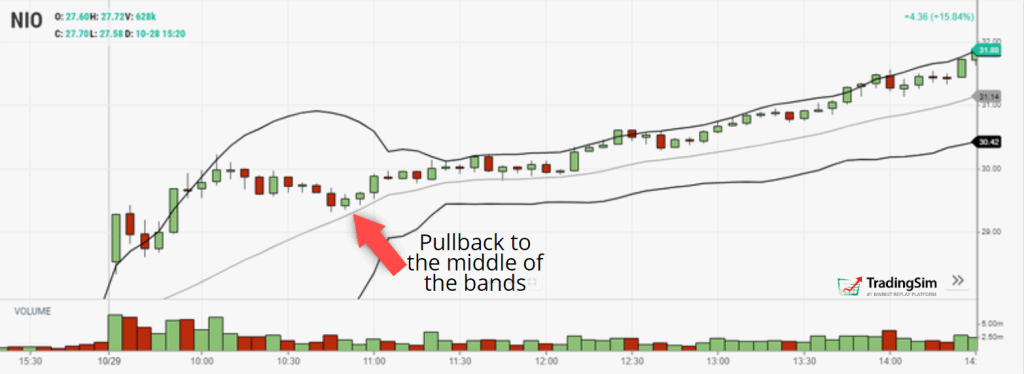
Middle of the bands pullbackAs you can see in the above example, notice how the stock had a sharp run-up, only to pull back to the mid-line. You would want to enter the position after the failed attempt to break to the downside.
You can then sell the position on a test of the upper band. If you have an appetite for risk, you can ride the bands to determine where to exit the position.
#6 Strategy – Trade Inside the Bands
This is our favorite of the strategies.
Most of the money to be made in the market, with minimal risk, is in the margins.
The same way we say football is a game of inches, trading is the same.
You, of course, can make a ton of money placing big bets, but these types of traders usually do not make it over a long trading career (20+ years).
Example
First, you need to find a stock that is stuck in a trading range. The greater the range, the better.

Trading RangeNow, looking at this chart, you may feel a sense of boredom overcoming you. That’s because it’s far more entertaining to tell yourself and others you crushed a 20% day trade in one day.
However, from experience, the traders that take money out of the market when it presents itself, are the ones sitting with a big pile of cash at the end of the day.
In the above example, simply buy when a stock tests the low end of its range and the lower band. Conversely, you sell when the stock tests the high of the range and the upper band.
Bands Help Identify Ranges
The key to this strategy is a stock having a clearly defined trading range. This way you are not trading the bands blindly but are using the bands to gauge when a stock has gone too far.
You could argue that you don’t need the bands to execute this strategy. However, by having the bands, you can validate that a security is in a flat or low volatility phase, by reviewing the look and feel of the bands.
A simpler way of saying this is that the bands help validate that the stock is stuck in a range.
So, instead of trying to win big, you just play the range and collect all your pennies on each price swing of the stock.
What if the Bands Fail?
This section is going to feel like a nice cold splash of water right in your face.
Surely you didn’t think Bollinger Bands would paint this rosy picture of trading bliss, did you?
Like anything else in the market, there are no guarantees. No doubt, Bollinger Bands can be a great tool for identifying volatility in a security, but it can also prove to be a nightmare when it comes to newbie traders. Don’t skip ahead, but I will touch on this from my personal experience a little later in this article.
Like any other trade signal, you will need to exit your position without reservation.
Not exiting your trade can almost prove disastrous as three of the aforementioned strategies are trying to capture the benefits of a volatility spike.
For example, imagine you are short a stock that reverses back to the highs and begins riding the bands. What would you do?
Let me help you out if you are confused – kill the trade!
While bands do a great job of encapsulating price movement, it only takes one extremely volatile stock to show you the bands are nothing more than man’s failed attempt to control the uncontrollable.
While there is still more content for you to consume, please remember one thing – you must have stops in place!
Which Strategy Works Best?
This is the important question for anyone reading this article. But it is such a tough question to answer.
To that end, I’ll offer my own personal experiences. For me, there are two strategies that I prefer to use – 5 and 6.
This doesn’t mean the others might not work well for you. But we all have different personalities and trading styles.
Both of these work well, but in two very different types of markets.
Strategy #5 – Snap Back to the Middle of the Band
This Strategy will work in very strong markets. It affords you the flexibility of jumping on a hot stock while lowering your risk as you wait for the pullback.
I have been a breakout trader for years. But I will be the first to tell you that most breakouts fail. Not to say pullbacks are without their issues, but you can at least minimize your risk by not buying at the top.
Strategy #6 – Trade Inside the Bands
This approach will work well in sideways markets and will also have a high winning percentage.
How do I know it has a high winning percentage?
Because you are not asking much from the market in terms of price movement. From my personal experience of placing thousands of trades, the more profit you search for in the market, the less likely you will be right.
Now, while strategies 5 and 6 work best for me, what say you?
Since trading is a personal journey, we’ve created this strategy/profile matrix to help you uncover which might work best for you.
Strategy Profile Matrix
- Strategy #1 Double Bottom – for the pure technician. The trader that is going to scan the entire market looking for a particular setup. It will require a lot of patience to identify the setup since you need the second bottom to breach the bands to generate a powerful buy signal.
- Strategy #2 Reversals – calling all risk takers! This approach is fantastic when you get it right because the reversal will pour money into your account. However, get things wrong, and the pain can often leave you paralyzed from taking any action. You must be quick on your toes and willing to cut a loser without blinking.
- Strategy #3 Riding the Bands – for the home run hitters. You must have the sheer will to only average a 20% to 30% win ratio because you will make all of your money on the big moves. That sounds easy, doesn’t it? Well, I have tried systems that have low win percentages, and I have failed every time. This is because I am a sore loser. Therefore, I can’t handle being wrong that infrequently. So, if you want to take less action and can seriously handle being wrong eight out of ten times, this system will be perfect for you.
- Strategy #4 The Squeeze – this is the best setup for the traders that want the profit potential of riding the bands but can take quick money as things go in your favor. You can take one of two approaches with the squeeze strategy. For the riskier traders, you can jump in before the break and capture all of the gains. More conservative traders can wait for the break and then look for a pullback setup in the direction of the primary trend.
- Strategy #5 Playing the Moving Average – this is for the dip buyers. You are looking for stocks that are trending strongly and then react back to the 20-period moving average. This setup works lovely when day trading the Nikkei and usually develops a little after forty-five minutes into the session.
- Strategy #6 Trading the Range – for the edge traders. For me, it comes down to the simple fact markets are range bound 80% of the time. So, if you need thrills, this strategy will put you to sleep. You will likely want to focus on #2, #3, or #4.
Bollinger Bands and Cryptocurrencies
In addition to strategies, there are a few items related to bands I need to cover that will provide you with a full picture of the indicator.
Don’t worry; I’m not about to go on a history lesson on cryptocurrencies with details of where David Chaum went to college.
Instead, I want to center this piece of the article on how you can use bands to trade bitcoin.
Bitcoin Volatility
I was reading an article on Forbes, and it highlighted six volatile swings of bitcoin starting from November 2017 through March 2018. The swings vary from gains of 223% to losses of 40%.
Doing my research, I looked at some of these price swings of Bitcoin in the Tradingsim platform.
These price swings are breathtaking!
Let’s dig deeper into this price action by looking at the charts.
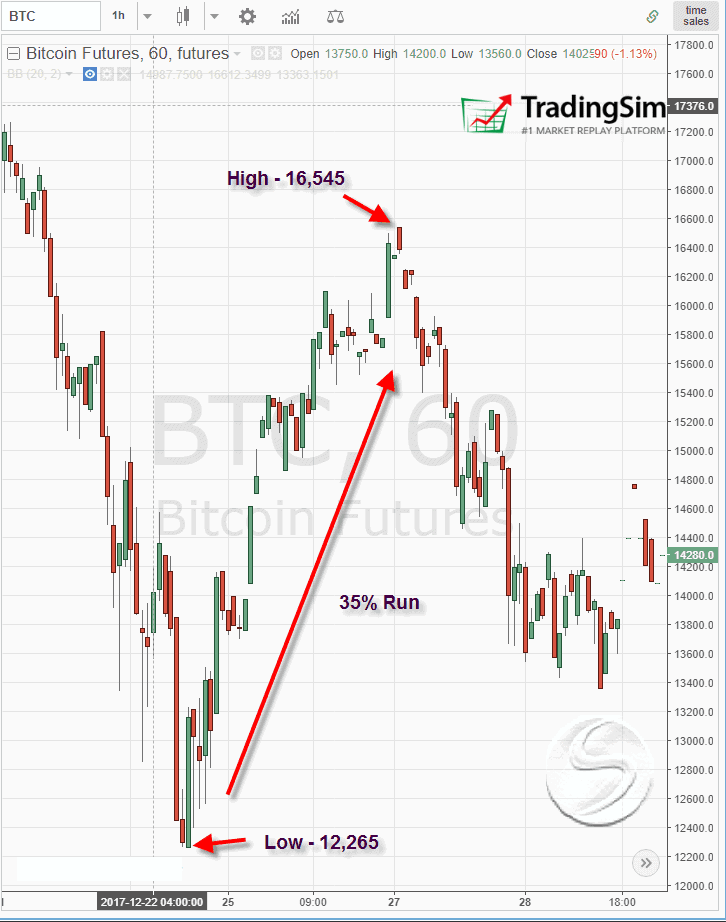
Bitcoin 2017 Holiday RallyLet’s look at the period of December 22, 2017, to December 27, 2017. During this period, Bitcoin ran from a low of 12,265 to a high of 16,545. This represents a run of ~35%.
Surprisingly, these gains were largely made over three days’ worth of trading.
That kind of money that fast can be hard to grasp. The psychological warfare of the highs and the lows become unmanageable.
So, it got me thinking, would applying bands to a chart of bitcoin futures have helped with making the right trade?
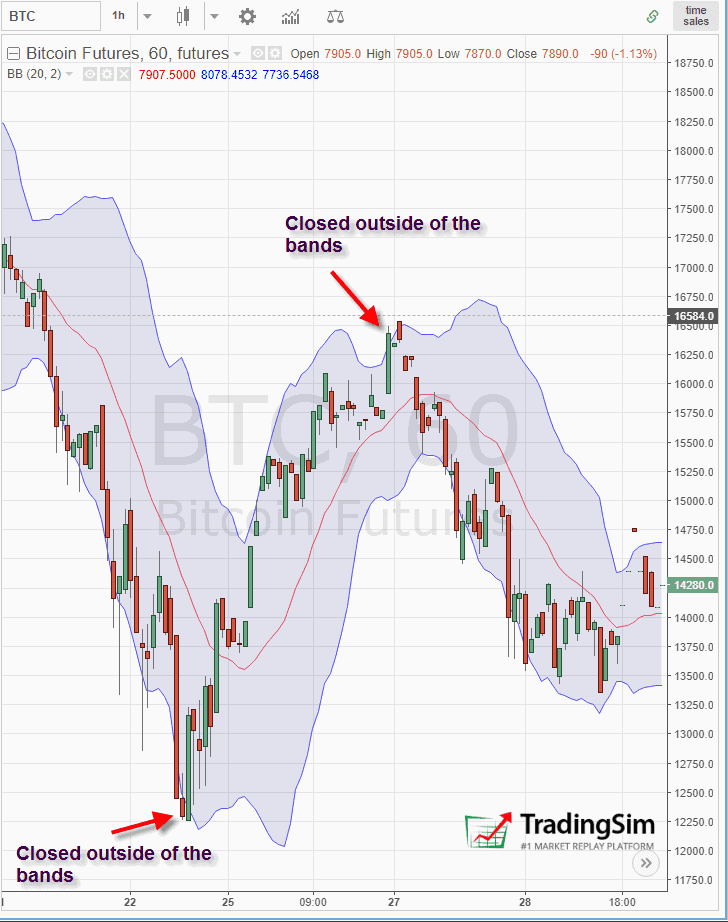
Bitcoin with Bollinger BandsI indicated on the chart where bitcoin closed outside of the bands as a possible turning point for both the rally and the selloff. But let’s be honest here, this is a 60-minute chart of a highly volatile security.
You must honestly ask yourself if you will have the discipline to make split-second decisions to time this trade, just right.
The one thing the bands manages to do as promised is contain the price action, even on something as wild as bitcoin.
Daily Price Chart
As you can see, the 60-minute chart is busy, so let’s take things up to the daily level.
For this example, let’s review the rally from the low of 5,980 on 2/6/2018 to a swing high of 11,785 on 2/20/2018.
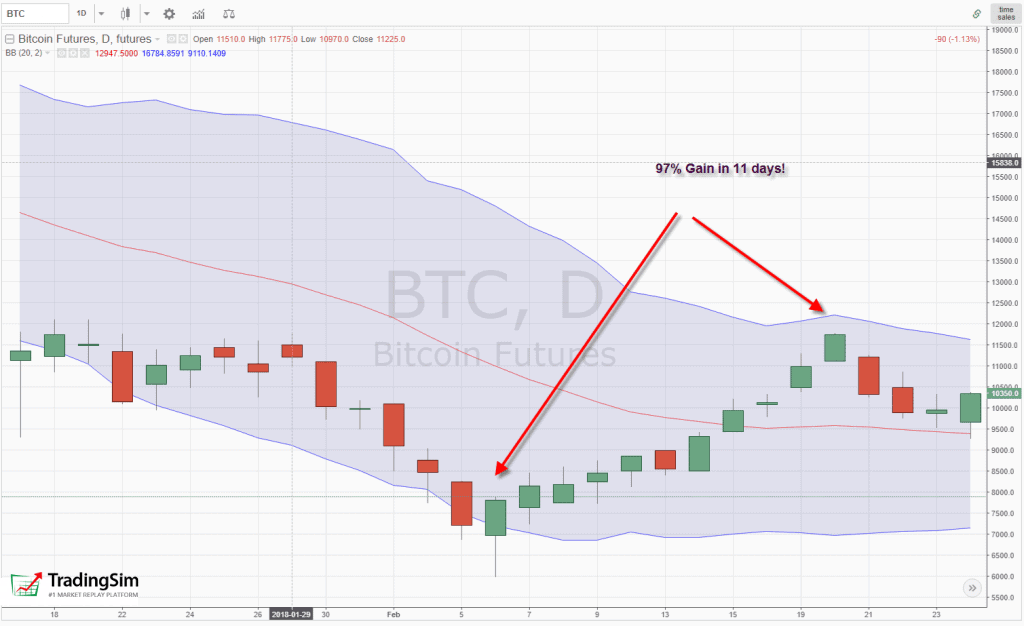
Bitcoin 97% Gain in 11 Days
I honestly find it hard to determine when bitcoin is going to take a turn looking at the bands. This chart is illustrating a 97% run over an 11-day period.
It’s not that the bands are doing anything wrong or not working. Bitcoin is just illustrating the harsh reality when trading volatile cryptocurrencies that there is no room for error.
I do not trade bitcoin. But after looking at the most recent price swing using bands, a couple of things come to mind:
- Honor your stops. Sometimes we talk ourselves into thinking that “things will work out,” but with volatile securities, you are essentially gambling.
- Only invest money you are willing to lose. Losing should never be your goal, but you shouldn’t risk your home or life savings trading cryptocurrencies.
- Short with caution. Cryptocurrencies can go on massive runs in a short period, so you need to make sure you honor those stops and have enough cash on hand to avoid margin calls.
Combining Bollinger Bands and Bollinger Bands Width
Pairing the Bollinger Band width indicator with Bollinger Bands is like combining the perfect red wine and filet mignon.
In the previous section, we talked about staying away from changing the settings. Well, if you think about it, your entire reasoning for changing the settings in the first place is in hopes of identifying how a security is likely to move based on its volatility.
A much easier way of doing this is to use the Bollinger Bands width. In short, the BB width indicator measures the spread of the bands compared to the moving average to gauge the volatility of a stock.
Why is this important to you?
Essentially, you have an actual reading of the volatility of a security. You can then look back over months or years to see if there are any repeatable patterns of how price reacts when it hits extremes.
Example
To see this in action, look at the below screenshot using both the Bollinger Bands and Bollinger Band width.
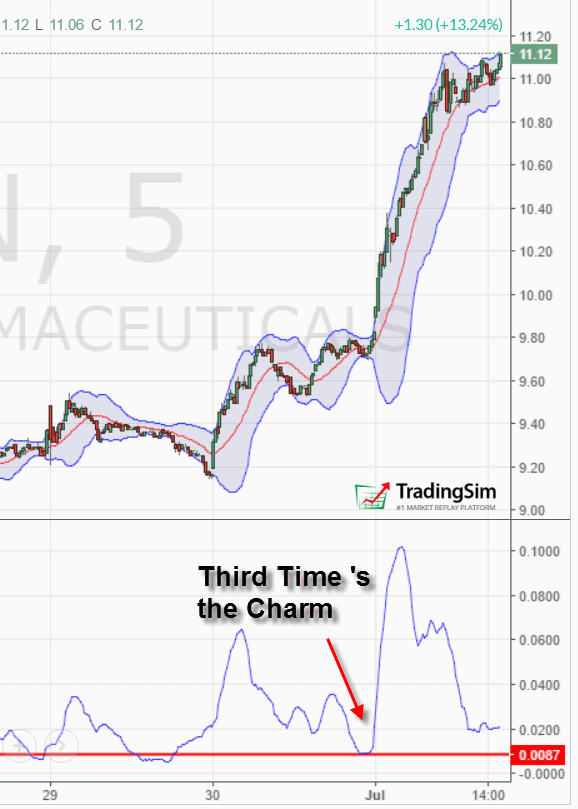
Third Time’s the Charm – Bollinger Band WidthNotice how the Bollinger Bands width tested the .0087 level three times. The other point of note is that on each prior test, the high of the indicator made a new high, which implied the volatility was expanding after each quiet period.
As a trader, you need to separate the idea of a low reading with the Bollinger Bands width indicator with the decrease in price. Remember, Bollinger Band width is informing you that a pending move is coming, the direction and strength are up to the market.
In this example, the 5-minute chart ofSciclone Pharmaceuticals (SCLN) had a huge runup from $9.75 to 11.12.
If you had just looked at the bands, it would be nearly impossible to know that a pending move was coming. You would have no way of knowing that .0087 was a level that existed, let alone a level that could trigger such a large price movement.
This is just another example of why it’s important to pair Bollinger Bands with other indicators and not use it as a standalone tool.
Can Bollinger Bands Predict Huge Price Moves?
This is always a fun question: Can an indicator somehow provide you clues of a major price swing?
With the bull market in full force in 2018, volatility dropped to a multi-year low.

Big Run in E-Mini FuturesThe above chart is of the E-Mini Futures. I want to dig into the E-Mini because the rule of thumb is that the smart money will move the futures market which in turn drives the cash market.
It is probably a little hard to see the explosion in volatility at the top of this chart, so let’s zoom in a bit.

Who Knew A Top was In?Looking at the chart of the E-mini futures, the peak candle was completely inside of the bands. Other than the fact the E-mini was riding the bands for months, how would you have known there was a big break coming?
Now that I have built up tremendous anticipation let’s see if there is a way to identify an edge.
Remember in Chapter 4, the Bollinger Band width can give an early indication of a pending move as volatility increases.
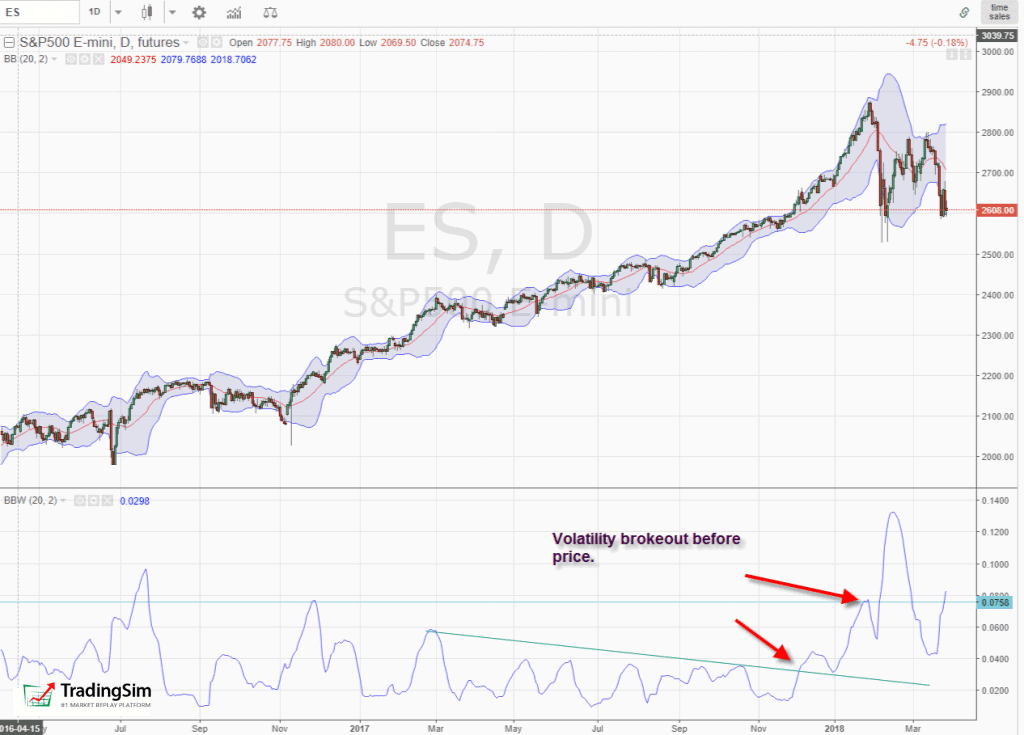
Volatility BreakoutIn the above example, the volatility of the E-Mini had two breakouts prior to price peaking. First, the Bollinger Band width had been coiling for approximately five months before breaking out.
If that wasn’t enough to convince you, then the second break above the 8-month swing high of the Bollinger Band width indicator was your second sign.
After these early indications, the price went on to make a sharp move lower and the Bollinger Band width value spiked.
Applying Bollinger Bands to a Volatility Indicator
The inspiration for this section is from the movie Teenage Mutant Ninja Turtles, where Michelangelo gets super excited about a slice of pizza and compares it to a funny video of a cat playing chopsticks with chopsticks.
The point is, it’s so far out there you have to actually try it out to see if it works.
To this point, we applied bands to the Proshares VIX Short-Term Futures to see if there were any clues before the major price movement we discussed earlier.
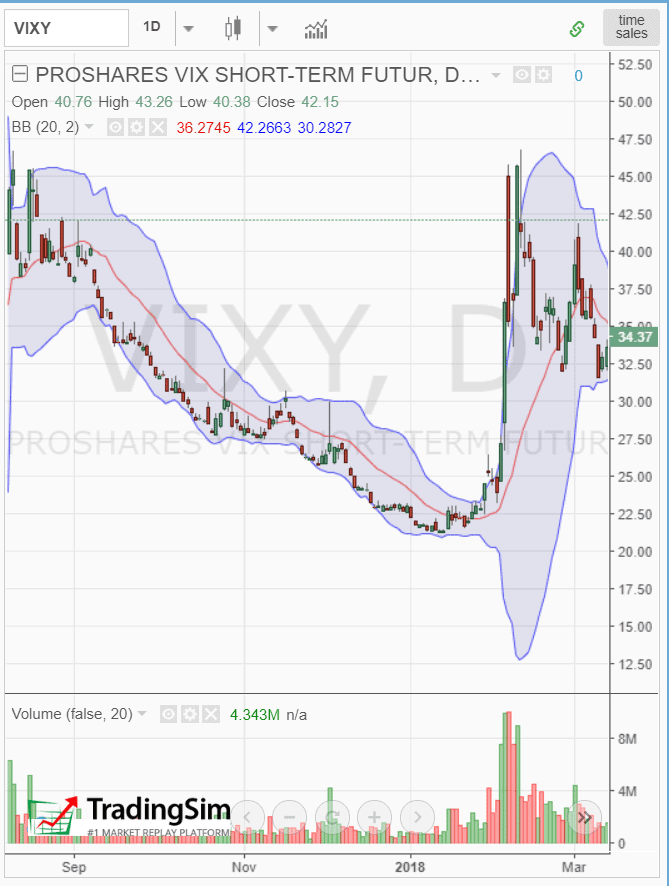
VIXY ChartDoes anything jump out that would lead you to believe an expanse in volatility is likely to occur?
Look hard and resist the urge to scan a few inches down the page for the answer.
It’s clear that the VIXY had a breakout by 2/2/2018. But at this point, you would have missed a large portion of the initial breakdown in price.
Being Late
When you are trading in real-time, the last thing you want to do is show up late to the party. More times than not, you will be the one left on cleanup after everyone else has had their fun. In other words, you’ll be left holding the bags.
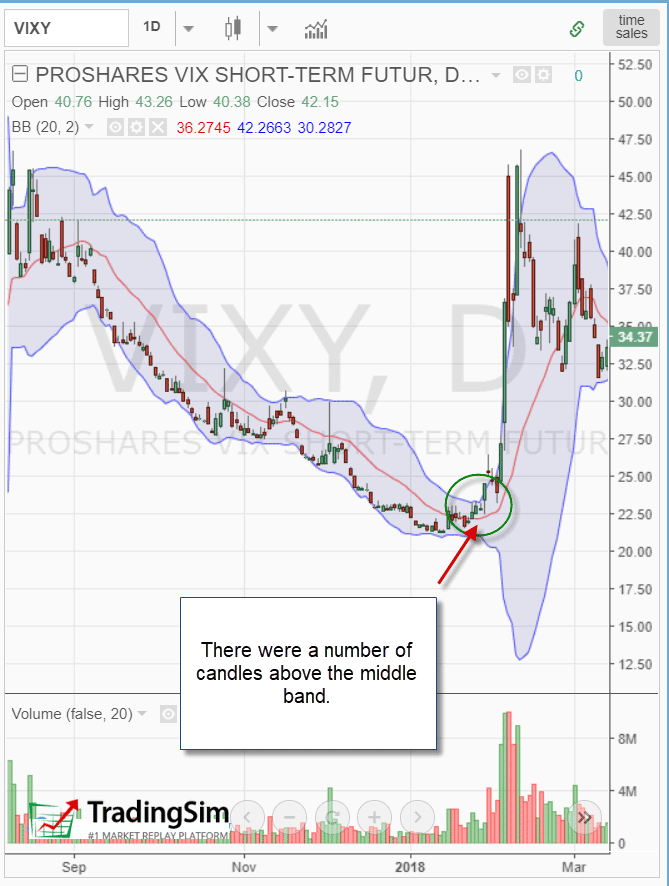
Breakout of VIXYIt was very subtle, but you can see how the bands were coiling tighter and tighter from September through December. During this time, the VIXY respected the middle band.
There was one period in late November when the candlesticks slightly jumped over the middle line. But there was no follow through and it immediately rolled over.
However, in late January, you can see the candlesticks not only closed above the middle line but also started to print green candles.
One could argue that this wasn’t enough information to make a trading decision. And that might be a fair statement.
You would need a trained eye and have a good handle with market breadth indicators to know that this was the start of something real.
There was one other clue on the chart. Can you see it?
This one is a little more obvious and it’s the pickup in volume.
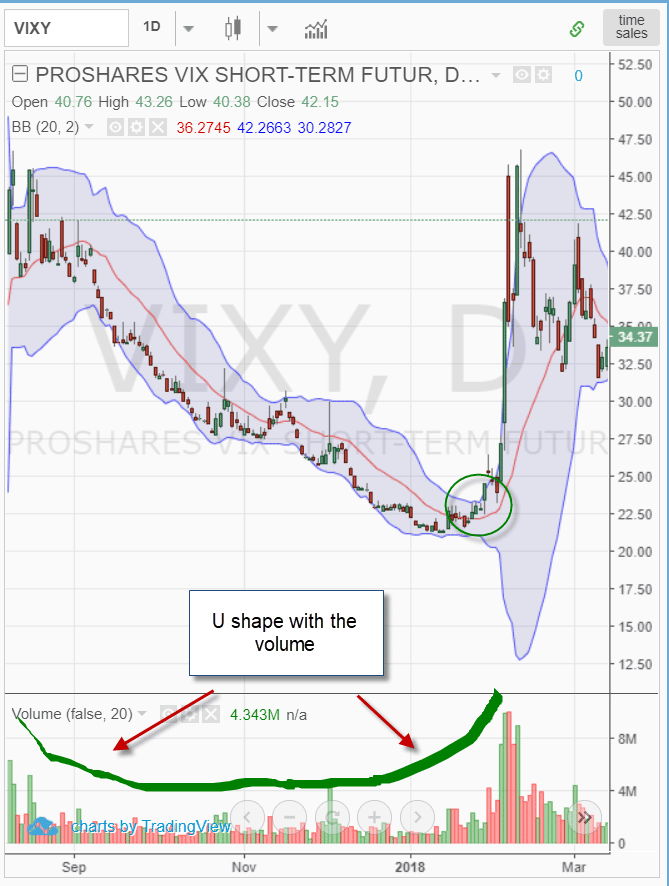
U Shape Volume
There is the obvious climactic volume which jumps off the chart, but there was a slight pickup in late January, which was another indicator that the smart money was starting to cash in profits before the start of the correction.
Helpful Bollinger Bands Resources and My Personal Experience with Bollinger Bands
Before we jump into my personal experience, look at the below infographic titled ’15 Things to Know about Bollinger Bands’.
The information contained in the graphic will help you as a reminder of the strategies we’ve discussed, plus give you more ideas and resources.
My Journey with the Bands
It’s safe to say Bollinger Bands is probably one of the most popular technical indicators in any trading platform.
If memory serves me correctly, Bollinger Bands, moving averages, and volume were my first indicators as a beginner trader.
Nowadays, I no longer use bands in my trading. That doesn’t mean they can’t work for you, but my trading style requires me to use a clean chart.
So, why did I end up abandoning the bands?
I tend to over analyze setups; it’s just what I do.
Therefore, the more signals on the chart, the more likely I am to act in response to a signal. This is where the bands expose my trading flaw.
For example, if a stock explodes above the bands, what do you think is running through my mind? You guessed right, sell!
The stock could just be starting its glorious move to the heavens, but I am unable to mentally handle the move because all I can think about is the stock needs to come back inside of the bands.
Day Trading in 2007
Flashback to 2007, when I was just starting in day trading; I had no idea what I was doing.
Instead of taking the time to practice, I was determined to turn a profit immediately and was testing out different ideas.
One of the first indicators I put to the test was Bollinger Bands.
Why? It’s one of the most popular indicators.
I decided to scalp trade. I would sell every time the price hit the top bands and buy when it hit the lower band. It’s really bad, I know. Shaking my head….
From what I remember, I tried this technique for about a week, and at the end of this test, I had made Tradestation rich with commissions.
The key flaw in my approach was that I did not combine the bands with any other indicator. This left me putting on so many trades that at the end day my head was spinning.
What it Takes to Trade with Bollinger Bands
To truly harness the power of the indicator, you need to learn how the bands interact with the price of a security. At the end of the day, bands are a means for measuring volatility. So, it’s not something you can just pick up and use for buy and sell signals.
Just as you need to learn specific price patterns, you also need to find out how bands respond to certain price movements.
This ability to identify the setups will help you avoid the false signals from the real ones.
This level of mastery only comes from placing hundreds, if not thousands of trades in the same market.
Bollinger Bands in the Trading Community
I went onto Amazon to search for the most popular books to see who the leaders are in the space.
No surprise, John Bollinger had the most popular book – “Bollinger on Bollinger Bands.”
The thing that surprised me is that I couldn’t find many other famous authors or experts in the space. I’m not sure if this is because there aren’t many people interested or if other traders stay out of the bands arena because John is so actively evangelizing his own indicator.
The books I did find were written by unknown authors and had less material than what I have composed in this article. The other hint that made me think these authors were not legit is their lack of using the registered trademark symbol after the Bollinger Bands title, which is required by John for anything published related to Bollinger Bands.
Conversely, when I search on Elliott Wave, I find a host of books and studies both on the web and in the Amazon store.
I am still unsure what this means exactly. With there being millions of retail traders in the world, I have to believe there are a few that are crushing the market using Bollinger Bands.
I just struggled to find any real thought leaders outside of John. I write this not to discredit trading with bands, just to inform you of how bands are perceived in the trading community.
What are the Best Time Frames for Trading with Bollinger Bands?
Bollinger Bands work well on all time frames. Remember, price action performs the same, just the size of the moves are different.
What are the Best Markets for Bollinger Bands?
Without a doubt, the best market for Bollinger Bands is Forex. Currencies tend to move in a methodical fashion allowing you to measure the bands and size up the trade effectively.
Next, I would rank futures because again you can begin to master the movement of a particular contract.
Last on the list would be equities. The captain obvious reason for this one is due to the unlimited trading opportunities you have at your fingertips.
It’s one thing to know how the E-mini contract will respond to the lower band in a five-day trading range.
It’s another thing to size up one stock from another in terms of how it will respond to the bands.
Conclusion
These are but a few of the great methods for trading with bands.
The key point to remember is that Bollinger Bands gets you into the habit of thinking about volatility.
In order to take your Bollinger Bands trading strategies to the next level, we recommend the following:
- Settle on a market you want to master (i.e., futures, equities, forex). If you try to learn all three at the same time, you are going down a painful road.
- Figure out what time frame works best for you.
- Learn to master one strategy before attempting to tackle them all. Any of the strategies mentioned can work given the right market environment and your willingness to honor your trading plan. However, similar to points one and two above, learn how to focus on getting one thing right before complicating things.
To practice the Bollinger Bands trading strategies detailed in this article, please visit our homepage at Tradingsim.com.
We provide a risk-free environment to practice trading with real market data over the last 3 years.
To continue your research on the Bollinger Bands indicator, please visit John Bollinger’s Official website. Here you will see a number of detailed articles and products.
External References
- Bollinger Bands Formula. Wikipedia
- Bollinger, John. Bollinger Bands Rules [Blog Post]. Bollingerbands.com
- Hayes, Adam. (2019). Bollinger Band Definition [Blog Post]. Investopedia.com
- Bollinger, John. (2002). ‘Bollinger on Bollinger Bands‘. The Mc-Graw Hill Companies, Inc. p. 113
The post 6 Bollinger Bands® Trading Strategies + Video appeared first on - Tradingsim.
-------------------------------------------------
By: Al Hill
Title: 6 Bollinger Bands® Trading Strategies + Video
Sourced From: tradingsim.com/blog/bollinger-bands/
Published Date: Fri, 16 Jul 2021 20:22:00 +0000
Read More
Did you miss our previous article...
https://peaceofmindinvesting.com/stocks/powerful-momentum-divergence
.png) InvestingStocksToolsClubsVideosPrivacy PolicyTerms And Conditions
InvestingStocksToolsClubsVideosPrivacy PolicyTerms And Conditions
